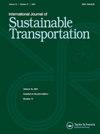Impact assessment for bicycle highway on cyclist’s PM2.5 exposure: Evidence from Beijing
IF 3.1
3区 工程技术
Q2 ENVIRONMENTAL STUDIES
International Journal of Sustainable Transportation
Pub Date : 2025-06-03
DOI:10.1080/15568318.2025.2504531
引用次数: 0
Abstract
Elevated bicycle highways are increasingly piloted to enhance the efficiency and safety of cyclists, yet their impact on air pollution exposures remains underexamined. This study assessed the effectiveness of bicycle highways in reducing exposure to particulate matters (PM2.5) in Beijing, China. Real-world measurements were conducted along three representative cycling routes connecting same working and residential areas, that is, route bicycle highways (RB), route arterials (RA), and route collectors (RC). Compared to RA and RC, RB are slightly longer (3.86% and 7.71%, respectively) but offer shorter travel times (1.28% and 4.79%, respectively). Notably, vertical-separated paths on RB significantly reduce concentration by up to 23.08% compared to vegetation-protected lanes. Although higher concentrations are observed near construction sites and transportation facilities, the absence of intersections on RB reduces exposure by 5.47% and 6.75% compared to RA and RC, respectively. A notable disparity between exposure hotspots and heavily polluted areas highlights the complex interactions of external factors, such as meteorological conditions, traffic patterns, and built environments. Linear and non-linear regression analyses (via OLS and XGBoost–SHAP) elaborate the significant contributions of meteorological conditions, traffic patterns, road design, and land use in shaping on-road exposures. These findings suggest the urgent need for an exposure-focused evaluation approach in bicycle infrastructure planning. By considering the complicated effects caused by these external factors, policymakers can develop targeted strategies to mitigate exposure risks and promote safer and healthier cycling environments.
自行车公路对骑行者PM2.5暴露的影响评价:来自北京的证据
为了提高骑车者的效率和安全性,高架自行车公路的试点越来越多,但它们对空气污染的影响仍未得到充分研究。本研究评估了中国北京自行车公路在减少颗粒物(PM2.5)暴露方面的有效性。实际测量是沿着连接相同工作和住宅区的三条代表性自行车路线进行的,即路线自行车公路(RB),路线动脉(RA)和路线收集器(RC)。与RA和RC相比,RB略长(分别为3.86%和7.71%),但行程时间较短(分别为1.28%和4.79%)。与植被保护车道相比,RB上垂直分隔的车道显著降低了浓度,最高可达23.08%。虽然在建筑工地和交通设施附近观察到较高的浓度,但与RA和RC相比,RB上没有十字路口分别减少了5.47%和6.75%的暴露。暴露热点和重污染地区之间的显著差异凸显了气象条件、交通模式和建筑环境等外部因素的复杂相互作用。线性和非线性回归分析(通过OLS和XGBoost-SHAP)详细阐述了气象条件、交通模式、道路设计和土地利用在形成道路暴露方面的重要贡献。这些发现表明,在自行车基础设施规划中迫切需要一种以暴露为重点的评估方法。通过考虑这些外部因素造成的复杂影响,决策者可以制定有针对性的策略来降低暴露风险,促进更安全、更健康的骑行环境。
本文章由计算机程序翻译,如有差异,请以英文原文为准。
求助全文
约1分钟内获得全文
求助全文
来源期刊
CiteScore
8.90
自引率
2.60%
发文量
56
期刊介绍:
The International Journal of Sustainable Transportation provides a discussion forum for the exchange of new and innovative ideas on sustainable transportation research in the context of environmental, economical, social, and engineering aspects, as well as current and future interactions of transportation systems and other urban subsystems. The scope includes the examination of overall sustainability of any transportation system, including its infrastructure, vehicle, operation, and maintenance; the integration of social science disciplines, engineering, and information technology with transportation; the understanding of the comparative aspects of different transportation systems from a global perspective; qualitative and quantitative transportation studies; and case studies, surveys, and expository papers in an international or local context. Equal emphasis is placed on the problems of sustainable transportation that are associated with passenger and freight transportation modes in both industrialized and non-industrialized areas. All submitted manuscripts are subject to initial evaluation by the Editors and, if found suitable for further consideration, to peer review by independent, anonymous expert reviewers. All peer review is single-blind. Submissions are made online via ScholarOne Manuscripts.

 求助内容:
求助内容: 应助结果提醒方式:
应助结果提醒方式:


